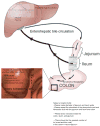Microbes, microbiota, and colon cancer
- PMID: 24629338
- PMCID: PMC4003880
- DOI: 10.1016/j.chom.2014.02.007
Microbes, microbiota, and colon cancer
Abstract
Colorectal cancer (CRC) presents a considerable disease burden worldwide. The human colon is also an anatomical location with the largest number of microbes. It is natural, therefore, to anticipate a role for microbes, particularly bacteria, in colorectal carcinogenesis. The increasing accessibility of microbial meta'omics is fueling a surge in our understanding of the role that microbes and the microbiota play in CRC. In this review, we will discuss recent insights into contributions of the microbiota to CRC and explore conceptual frameworks for evaluating the role of microbes in cancer causation. We also highlight new findings on candidate CRC-potentiating species and current knowledge gaps. Finally, we explore the roles of microbial metabolism as it relates to bile acids, xenobiotics, and diet in the etiology and therapeutics of CRC.
Copyright © 2014 Elsevier Inc. All rights reserved.
Figures



References
Publication types
MeSH terms
Grants and funding
- R01CA154426/CA/NCI NIH HHS/United States
- R01CA179440/CA/NCI NIH HHS/United States
- R01 CA151325/CA/NCI NIH HHS/United States
- K08AI078942/AI/NIAID NIH HHS/United States
- R01 CA154426/CA/NCI NIH HHS/United States
- R21CA170492/CA/NCI NIH HHS/United States
- R01 CA179440/CA/NCI NIH HHS/United States
- R01CA151325/CA/NCI NIH HHS/United States
- R01CA151393/CA/NCI NIH HHS/United States
- R01 CA151393/CA/NCI NIH HHS/United States
- R21 CA170492/CA/NCI NIH HHS/United States
- K08 AI078942/AI/NIAID NIH HHS/United States
- P30 DK034854/DK/NIDDK NIH HHS/United States
LinkOut - more resources
Full Text Sources
Other Literature Sources
Medical

